 |
||
|
||
| ||
Testing internal CD-RW drives for a quite a long time, I have noticed that these gray or white boxes do not differ much in design, since recorder manufacturers often don't pays due attention to the appearance of their products. The rare exceptions do not usually show brilliant functionality or high disc recording quality. The simplest way to implement design innovations is in external CD-RW drivers. But the majority of manufacturers take the easy way out by simply packaging internal devices into a brick-like case. The only company which really cares about the appearance of their products is Iomega. Iomega launched the ZipCD USB Drive for the external USB CD-RW drive market. An original design and questionable mobility indicate that the drive was intended for stationary usage. A more interesting solution was Iomega's Predator. It's difficult to say what the engineers meant by its name. Maybe they wanted the Predator become a leader in the USB CD-RW drive market by tearing their competitors to shreds. Whatever the case may be, today we will try to study the tempers of the both drives in our tests, so let's now turn right to the test results of these devices. The external recorders were tested on a machine built on the ASUSTeK A7V mainboard, CPU Athlon 750 MHz, 256 MBytes memory and HDD IBM DTLA 45 GBytes. Asin the case with SCSI recorders, we were not able to use the CD-ROM Drive Analyzer program since it doesn't work with CD-RW drives with USB interfaces. Fortunately, the lack of a benchmarking program was solved by one of our readers, Viktor Romanov, who had written his own program called WinDiskTest. Test resultsSince the drives have nearly identical characteristics, their results are also very close. And aiming at saving you time we will omit the test results which carry no important information. CDWinBench 99 CD-ROM Transfer RateThe CD-ROM Teac 540ET was chosen to compare the performance in reading operations. Although it is not normally correct to compare the internal IDE-model with the external USB ones, it is still significant.  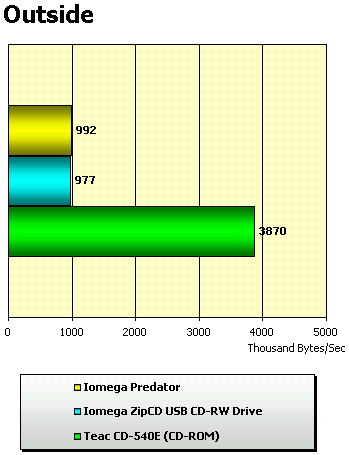 The tests show that the Iomega recorders work at the maximum transfer rates limited by the USB interface (remember that 1.5 MBytes/s is a peak speed and not an average data transfer rate via USB 1.1). That is why it becomes more interesting to connect the Predator to FireWire or USB 2.0 ports. The CPU utilization was: 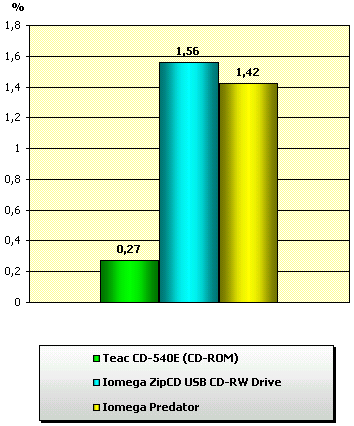 The USB-devices load the processor more heavily than the IDE drives do, while working more slowly than the CD-ROM TEAC. CDWinBench 99 CD-ROM Access Time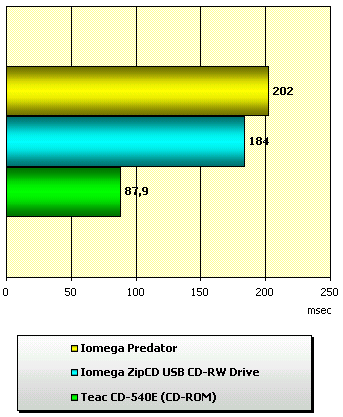 The specs of the Iomega recorder are difficult to find, and among ones I could uncover the access time is specified as "up to 125 ms" which has nothing to do with the results obtained in our tests: 184-202 ms. CDWinBench 99 CPU Utilization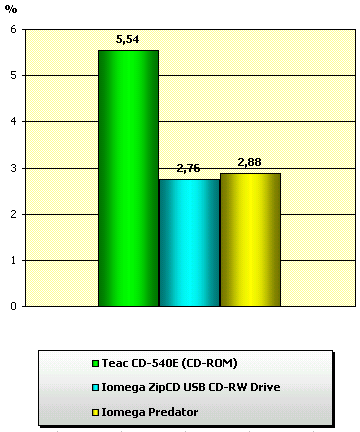 The total CPU utilization by the USB CD-RW drives from Iomega is quite low. But comparing it with the results of high-speed recorders, for example TDK CDRW161040 (1.94%) or Yamaha CRW2100E (2.63%), the Predator and ZipCD don't look so triumphant any more. Time spent for CD recordingFor comparison we have taken the TEAC W54E drive with the maximum recording speed equal to 4X; this model is the closest in speed characteristics to our drives. Recording of the CD-R Philips Silver Premium (cyanine, the rated record speed is 16x) 4X
Recording of the CD-R Mirex (phthalocyanine, the rated record speed is 12x) 4X
Recording of the CD-R Mirex (phthalocyanine, the rated record speed is unknown) 4X
There is no difference in the record speed between the drives. That is why when choosing among the internal IDE 4/4/32 or the external USB 4/4/6 recorders the time spent for recording CDs shouldn't be taken into consideration. Time spent for full formatting of a CD-RW disc in UDF formatPhilips CD-RW 4x
The recorders were tested with the Roxio software - DirectCD 3.03b. Probably, due to the newer version of the program the CD-RW TEAC W54E showed higher results than those published in the first part of our review cycle of IDE CD-RW drives. This improvement helped the W54 strengthen its leading position in this subtest. Recording of a CD-RW disc (UDF)Philips CD-RW 4x
The speed of operation of the external Iomega recorders with CD-RW discs is not as impressive as their appearance. Of course, the external CD-RW drive is meant not only for backup copying of huge data volumes on re-recordable discs. External devices are often bought for office use in order to copy a great amount of data from computers not connected to the local network. If there are 2 or 3 such computers and you are dealing with a small amount of data, then 2-3 extra minutes is not a big deal. But if the data volumes are not small, and you are archiving them several times a day, then you'd better replace one of those external drives with 3 internal cheap IDE recorders like the TEAC W54. BLER factor of CD-R discs recorded with the Iomega drivesThe BLER factors for the both drives are almost identical. Both drives don't like the dark blue cyanine "noname" CD-R media. Right from the start the Predator failed to recognize it as a blank disc. The second attempt was more successful. So, here are the results:
(for the tests we used a device described in the fifth part of our review) On the whole the results are not that bad. As for the chinese discs, I should note that the recorders don't like them much. The disc recorded with the Predator two weeks ago was read with great difficulties. CDTest 99Both drives read the lab-recorded and the factory-recorded CD-Rs equally well: pure 6X speed ;-) The graph of reading of the recorded CD-R Philips Silver Premium (4x record speed) 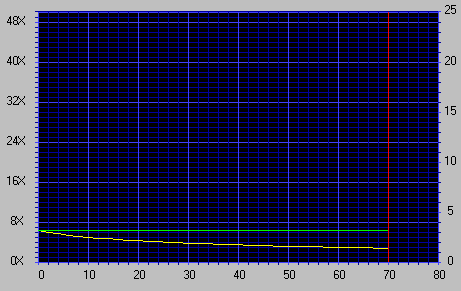 The graph of reading of the recorded CD-R Mirex (4x record speed) 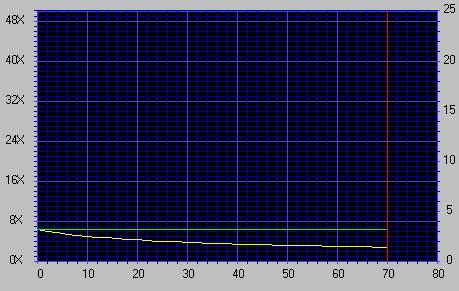 The graph of reading of the recorded CD-R "noname" (4x record speed) 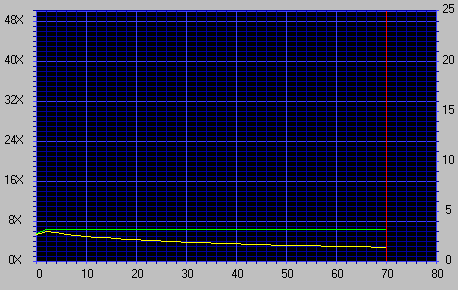 A green line shows a read speed (left scale), a yellow one indicates the disc rotational speed (right scale, thousand rpm). Well, did you expect something more than CLV reads at 6X? CD Speed 99 test results of the recorded CD-R Philips Silver Premium.
CD Speed 99 test results of the recorded CD-R Mirex.
CD Speed 99 test results of the recorded CD-R "noname"
I hope you understand why the Disc Load Time and Disc Recognition Time are unknown: the device can open the lid automatically, but can't close it :-) The CD-RW Iomega ZipCD is true to its specs as far as access time (125 ms ) is concerned. The Predator is more careless in this respect. The other parameters in this test are comparable. CD Speed 99 test results of the CD-RW (UDF) discs recorded at 4X.
CD Speed 99 test results of the recorded CD-RW (ISO).
The "beast" ( I mean the Predator) works with the CD-RW discs much better both in recording and in reading. CD Quality Check test results of the recorded CD-R Philips Silver Premium
CD Quality Check test results of the recorded CD-R Mirex
CD Quality Check test results of the recorded CD-R "noname"
Read speed obtained with the WinDiskTest
The CD-RW Iomega Predator didn't pass the benchmark tests with the CD Quality Check utility. The program showed an error at the very beginning. The extra 0.2X matters much more than when reading with even the fastest internal IDE CD-ROM recorder. But at the same time we should allow for the internal error level of each program. That is why the difference in 50 KBytes/sec in reading mode between the devices under consideration in other conditions is not regular. Audio track extraction from audio CDs (CDDAE 99)Iomega ZipCD CD-RW Drive
Iomega Predator
* - 6.62% means that the drive extracted 6.62% of the CD with errors. The Iomega ZipCD simply refused work with the CD Piano Favorites. We did our best to make it read the disc; but we succeeded in nothing, be it cleaning, polishing, reloading etc. On any track the drive responded with "read error code ...". That is why the Predator takes the lead in this test. Direct copying from recorded CDs to a hard discCopying of the recorded CD-R Philips Silver Premium
Copying of the recorded CD-R Mirex
Copying of the recorded CD-R "noname"
Advanced DAE QualityUnfortunately, this test is also beyond the abilities of the Iomega ZipCD. The drive has certain problems when working with some Audio CDs. The CD-RW Iomega Predator's test results:
First of all, a rather big offset caught my eay. So, if you are going to use this recorder for making exact copies of Audio CDs, then you need good grabbing programs (like EAC), or you'd better extract audio tracks on another reading device. OverburnThe both CD-RW drives do not support the Overburn function. ConclusionUndoubtedly, these models will be mainly interesting for those who want their device to be mobile and implement carrying of huge amounts of data from one machine to another as simply as possible. Notebook owners will be pleased with the light weight of the Predator and its firm case. But on the other hand, this device has a weighty and bulky power supply unit, and for CD recording you need a socket to power you "beast". However, in this case the Predator doesn't use the notebook's batteries. Secondly, the Predator has the wrong construction for a mobile device. The case is quite reliable, but the USB-adapter can be easily disconnected, and there aren't any additional clamps. A dubious advantage is provided by the vertical position of a loaded disc. Music lovers will be disappointed by the lack of a "Play" button, not to mention other functions of a component AudioCD player. Certainly, the Predator has a heap of advantages. The CD-RW drive copes nicely with disc recording. Considering its appearance and its USB-interface, I must admit that it also perfectly copes with disc reading. Besides, it can be easily upgraded with FireWire or USB 2.0 adapter; the only open issue is the price of such an adapter. As for the CD-RW Iomega ZipCD, it is difficult to say what users the drive is going to please. Its rather large weight and bult will hardly suit notebook owners. I think that the drive will be primarily accepted by offices without a LAN, i.e. the drive will suit users primarily looking for a recording mobile device with a simple connection. Benchmark programs:
Write a comment below. No registration needed!
|
Platform · Video · Multimedia · Mobile · Other || About us & Privacy policy · Twitter · Facebook Copyright © Byrds Research & Publishing, Ltd., 1997–2011. All rights reserved. | |||||||||||||||||||||||||||||||||||||||||||||||||||||||||||||||||||||||||||||||||||||||||||||||||||||||||||||||||||||||||||||||||||||||||||||||||||||||||||||||||||||||||||||||||||||||||||||||||||||||||||||||||||||||||||||||||||||||||||||||||||||||||||||||||||||||||||||||||||||||||||||||